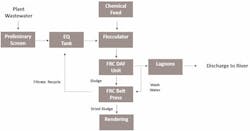Small Space Sludge Management
Central America’s largest poultry producer, DIP-CMI, faced new requirements to meet stricter wastewater discharge regulations with an outdated treatment system. The facility, located in San Jose, Costa Rica, processes more than 100,000 birds per day and prepares them for distribution to local markets. Maintaining legal compliance for discharging the effluent into the local waterway was not only important for continuing operations, but also a fundamental part of the plant’s environmental plan, which safeguards the local population the plant serves.
DIP-CMI reached out to JWC Environmental’s industrial wastewater group for assistance with the design and construction of an upgraded 1.9-million-liter-per-day wastewater treatment facility. The investigation into a viable solution to revamp its existing wastewater treatment infrastructure drove a comprehensive review of the facility’s end-to-end waste processes, including the wastewater sludge management plan and rendering operations.
New Limits, New Solutions
Common among poultry processing plants, the facility’s wastewater is heavily laden with organic contaminants, which contribute to elevated levels of total suspended solids (TSS); fats, oils and grease (FOG); and chemical oxygen demand (COD)—all of which are regulated water quality parameters. The existing DIP-CMI system included a simple fat trap that performed limited separation of FOG from the wastewater prior to effluent entering a surface aerated lagoon. While the fat trap system was relatively easy to maintain and produced little waste sludge, it would never have the capability to remove enough solids to stop the overloading of the biological process in the aerated lagoon.
To comply with the new direct discharge permit, the facility was required to meet concentration limits of less than 30 mg/L of TSS, less than 10 mg/L of FOG, and less than 100 mg/L of COD. JWC Environmental’s approach to this challenge introduced an FRC dissolved air flotation (DAF) system, which was preceded by an IPEC drum screen for initial solids separation.
As the team reviewed the full process flow, the next problem was the effect the DAF float sludge would have on the in-plant rendering process. The existing rendering operations were adequate for handling the offal and poultry feathers from the processing lines, but the high-moisture-content DAF sludge would quickly overwhelm the plant’s systems. Increasing the capacity of the plant’s rendering capabilities was not an option, so JWC was able to offer a belt filter press to dewater the sludge prior to rendering.
Tight on Space
A challenge in this overall plan was the limited space available at the facility to bring in new equipment. Due to its successful operations, DIP-CMI had grown poultry production at the San Jose facility to levels much greater than a plant of its size typically would handle. This constraint carried through to the wastewater system, and the allotted space for the new wastewater treatment infrastructure was unusually small for the volume of wastewater that needed to be processed. As such, the design of the equipment, as well as the layout of all the components in the building, needed to be pieced together in as tight a configuration as possible.
For the DAF system, JWC opted for its FRC PCL-60 plate-pack design to accommodate higher flow rates. These units are characterized by having taller tanks, rather than longer and wider ones, which means when floor space is limited, this design can take advantage of the available vertical space.
The FRC sludge dewatering belt press also employed the same vertical design characteristic—stacking each of the dewatering and pressing zones on top of one another—as opposed to arranging them in a lateral configuration like other comparable systems. With these technologies and the help of three-dimensional modeling, JWC designed a two-story system that fit within the allotted space and contained the process equipment necessary to meet the facility’s water quality requirements.
Up & Running
Once the system was brought online, the benefits of reviewing the full process came to light. The drum screen and DAF systems proved to be efficient in removing solids from the waste stream. While important for compliance, they also produced significant amounts of industrial sludge. By including the belt press, the plant was able to process the waste sludge without making costly upgrades to the rendering cookers.
The design team found additional savings for the sludge dewatering operations. Due to the cleanliness of the DAF effluent, it was used as the wash water for the belt press. This meant that no potable water was required in this part of the sludge management strategy.
The most important success came in the discharge results. Sampling data from the first six months of operation showed sufficient reduction in TSS, FOG and COD concentrations to safely comply with the new discharge permit limits.
Figure 1. Sludge Management Process Diagram
Going forward
DAF is an economical and efficient technology to treat wastewater with elevated levels of solids or oils in poultry processing as well as any animal rendering application. Having a successful wastewater upgrade means looking at more than just the immediate treatment solution. Designers must evaluate a plant’s complete wastewater system and consider options for management of sludge and other waste streams that might be produced.
As DIP-CMI continues to grow in Central America, the wastewater treatment technologies employed at the San Jose facility also will be used elsewhere to maintain the company’s environmental sustainability goals. The outlook of the food production market in Central and South America is bright, and as other companies continue to expand throughout the region, water quality regulations will require them to make the same efforts in environmental stewardship.

